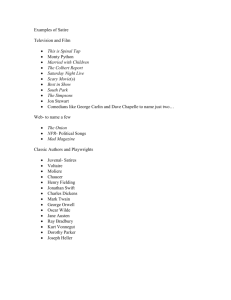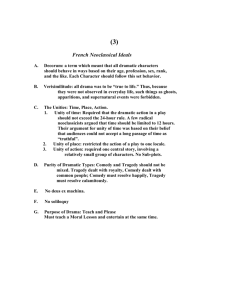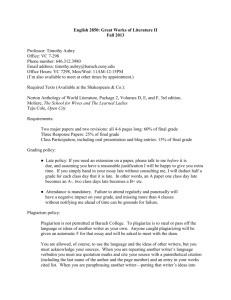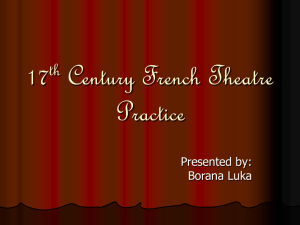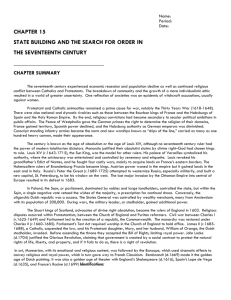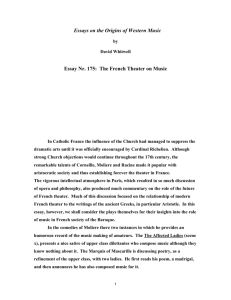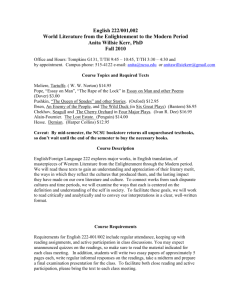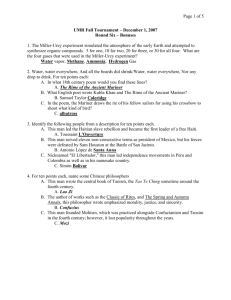French Neo-classism: Playwrights
advertisement
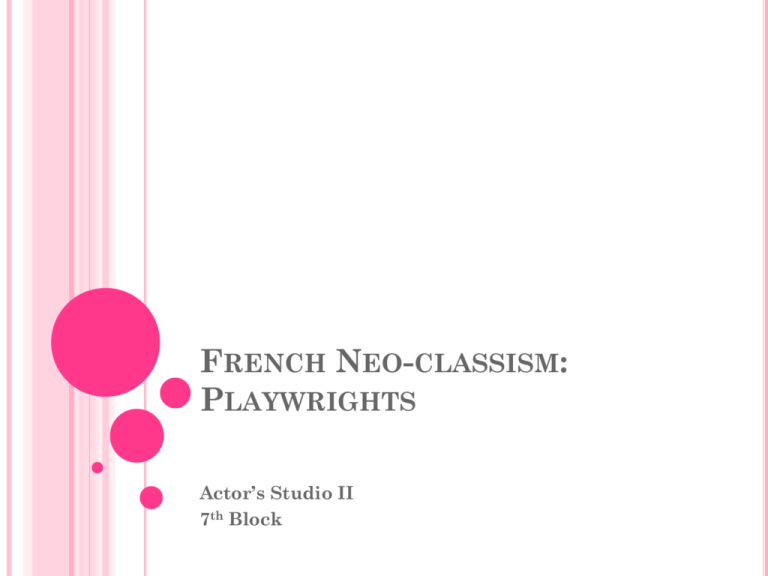
FRENCH NEO-CLASSISM: PLAYWRIGHTS Actor’s Studio II 7th Block PIERRE CORNEILLE Founder of French Tragedy PIERRE CORNEILLE 1606-1684 Known as Father of French Tragedy (but he also wrote several comedies) Most famous play: Le Cid (1637) The Academy denounced Corneille for his errors in Le Cid and he stopped writing drama for a few years Started writing again and proved himself to be one of the strongest playwrights of tragedy Many dramas focused on Roman stories LE CID Based on Spanish folklore Plot Notes: Story of two young lovers – Rodrigue and Chimene – whose fathers are enemies Rodrigue’s father wins honor at court and Chimene’s father defeats him in a duel meaning Rodrigue will have to fight to defend his father’s honor (meaning he must kill Chimene’s father) Rodrigue’s internal conflict: loyalty (father) vs. love (Chimene) Rodrigue kills Chimene’s father and she is then torn between her love for him and restoring her family’s honor Rodrigue saves the kingdom, becoming Le Cid, and the king will not risk his best fighter in a duel for honor King’s decree: couple must separate for a year so Chimene can mourn her father’s death then the couple will marry LE CID…ISSUES SURROUNDING THE PLAY Classical Elements: Tragedy (nobility, matters of state, verse) Unity of time and place Believable reactions by characters Moral dilemma from which the audience can learn The Issue: Breaks unit of action multiple times Classists did not approve of the play CORNEILLE’S CHARACTERISTICS IN LE CID Love story set against power struggle Internal struggle as characters face difficult choices “Tragicomedy” – tragic situations but ends happily Reasonable characters Characters see the logic and this takes the play from tragic to happy The fact that this happens reflects Corneille as a playwright and the time period in which he lived JEAN RACINE Corneille’s Rival JEAN RACINE 1639-1699 Simple plots with one moral problem shared by three characters (most of the time) Character struggle: personal want vs. public duty Characters behave in the manner expected of them even when they go crazy Never choose personal want over public duty Lesson for the audience Characters express themselves appropriately through language Writing includes strong imagery, verse, and high emotional intensity Plays: Phaedra, Andromache, and Berenice PHAEDRA Racine’s greatest work Plot: Phaedra is in love with Hippolytus (her stepson) but he loves Aricia Phaedra wants to die over her guilt (although she has only told one person – her confidante) Theseus (Phaedra’s husband) dies and when news reaches Phaedra her confidante urges her to tell Hippolytus how she feels Phaedra tells Hippolytus and he is appalled; soon after Theseus returns (very much alive) Phaedra accuses Hippolytus of loving her and Hippolytus chooses to leave rather than tell the truth about his stepmother Theseus places a curse on Hippolytus before he leaves Phaedra confesses the truth out of guilt…but it is too late – Hippolytus is killed by a sea-monster (to carry out the curse) and Phaedra commits suicide leaving Theseus alone PHAEDRA Unities of place, time, and action Verismilitude Observes proprieties Moral dilemma and the sin is punished Neo-classism plays all fit this, what makes Phaedra stand out? Passionate and strong emotional intensity Language and structure are both beautiful Great amounts of tension Racine fulfilled the requirements of neo-classism AND went above and beyond in creating incredible dramas that moved audiences Along with the neo-classism ideals he utilizes strong structure, theme, characters, language, and imagery MOLIERE France’s Greatest Comedic Playwright MOLIERE 1622-1673 Jean-Baptiste Poquelin Father was a furniture dealer and upholsterer – Moliere attended the Jesuit College de Clermont with children of prominent families Many assumed he would take over his father’s business but he received a degree in law Fell in love with Madeline Bejart – an actress and playwright He would have learned court etiquette which helped him later in life at the court of Louis XIV Prominent but poor family of actors Took the stage name Moliere and joined the Bejarts in 1643 Common at this time for French actors to take a stage name Moliere’s father also asked him to change his name so he wouldn’t shame the family MOLIERE Wrote one serious play and performed in many of Corneille’s work Comedies: 10 one-acts, comedy-ballets, and 12 five-act plays One-act plays Comedy-ballets Contemplate the follies of humans Greatest works: Tartuffe, The School for Wives, The Misanthrope, The Imaginary Invalid, and The Miser Learned from what he saw around him: Integrated music, dance, and visual comedy with humorous situations Five-act plays original and innovative comedy Single-situation, creative climax, and contrasting characters Used commedia dell’ arte tradition Studied the comedies of Coneille and Paul Scarron Observed comic actors of his time – specifically Jodelet (who would later perform Moliere’s works) Result: genius comedy COMMONALITIES IN MOLIERE’S WORKS Tricky servant character (derived from commedia dell’ arte) – often called a valet – was in many of Moliere’s plays Very cunning, energized, and crafty Eventually created a character similar to the valet but this character was a bit more subdued and reflective One character is generally driven to overwhelming passion for a certain idea/want and there is a calmer, reasonable character to encourage them to take a more average approach to their problem/want/idea Usually characters become reformed in the end leading to a comedic ending MOLIERE’S WORKS Storyline and general plot are the only similarities in Moliere’s plays Understood human nature to an incredible degree People experience the emotions and passions of his characters but he brings this to life without making the character appear flat or foolish Each character is given a unique personality and while ridiculous at times is reasonable at others – Moliere appreciated that people are not onedimensional so his characters were not onedimensional MOLIERE’S THEMES Wrote to reflect on society and human nature Makes the follies and mistakes of humans obvious and clear Pokes fun at courtiers and those who believe they are talented when they are lacking talent in reality Ridicules people who feel they are overly important (especially people who feel they have power over their household) Presents an honest look at those who are selfcentered and/or hypocritical Does not hide – nor exaggerate – the faults of people MOLIERE’S COMPANY Moliere and 11 actors (including Madeleine) formed The Illustrious Theatre 1650: Patronage from Prince de Conti (school friend) Performed 1644-1645; season was a failure; troupe went into bankruptcy and Moliere was imprisoned Prince de Conti had a religious conversion and withdrew patronage in 1656 Returned to Paris in 1658 – performed for the king Earned the right to perform at the Petit-Bourbon theatre every other day King’s brother became a patron of the company MOLIERE’S TROUBLES 1662: Moliere married Armande Bejart – Madeleine’s sister or daughter Moliere’s success continued to grow and his rivals wanted to find a way to stop his successes Claimed Armande was Moliere’s own daughter Others said Armande was having an extramarital affair and that Moliere was still in love with Madeleine 1663: The Versailles Impromptu – Moliere played himself; told critics to attack his works and acting but to leave his private life alone 1663: The Critique of The School for Wives – a piece about the reactions to a previous play; courtiers felt Moliere had ridiculed them MOLIERE’S TROUBLES 1664: King rescued Moliere by serving as godfather to his first child Wrote Tartuffe – people were horrified by the attacks on religion and religious leaders; the play was withdrawn until 1669 Beginning in 1666 he became quite ill and could only work off and on 1673: Moliere died hours after completing a performance of The Imaginary Invalid Denied a church burial because actors were not allowed to receive the sacraments King interfered after a special request from his friends and allowed him to be buried at night MOLIERE & NEO-CLASSISM No direct relationship because he wrote comedies (which were not highly regarded) Freedom to express himself because he wasn’t bound by the rules and standards of neo-classism Works reflect neo-classism ideals Obey all three unities (very few exceptions) Characters find a way to become reasonable and good in terms of morals (teach the audience a lesson) Gracious king ensures a happy resolution Exaggeration is in Moliere’s plays – but it is not unreasonable or unbelievable Example: Use slapstick bits to hit a negative character but the character feels pain MOLIERE’S LEGACY 1680: Moliere’s company became known as the Comedie Francaise 1689: Comedie Francaise receives its own theater – continued to perform the greatest works of the French Renaissance Comedie Francaise has since moved locations but is still performing today Pierre Marivaux is the only French playwright to achieve anywhere near the success in comedic writing as Moliere Continues to be the playwright comedic playwrights are judged against Richard Wilbur’s rhymed verse translations are popular in Western culture Still popular today – universal appeal and honest characterization of people
